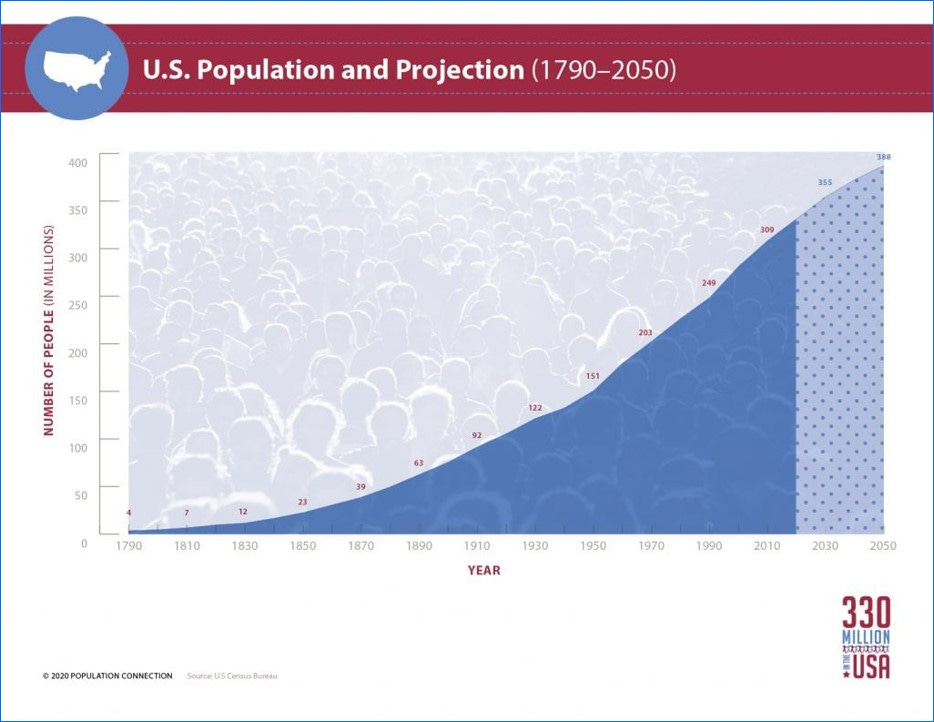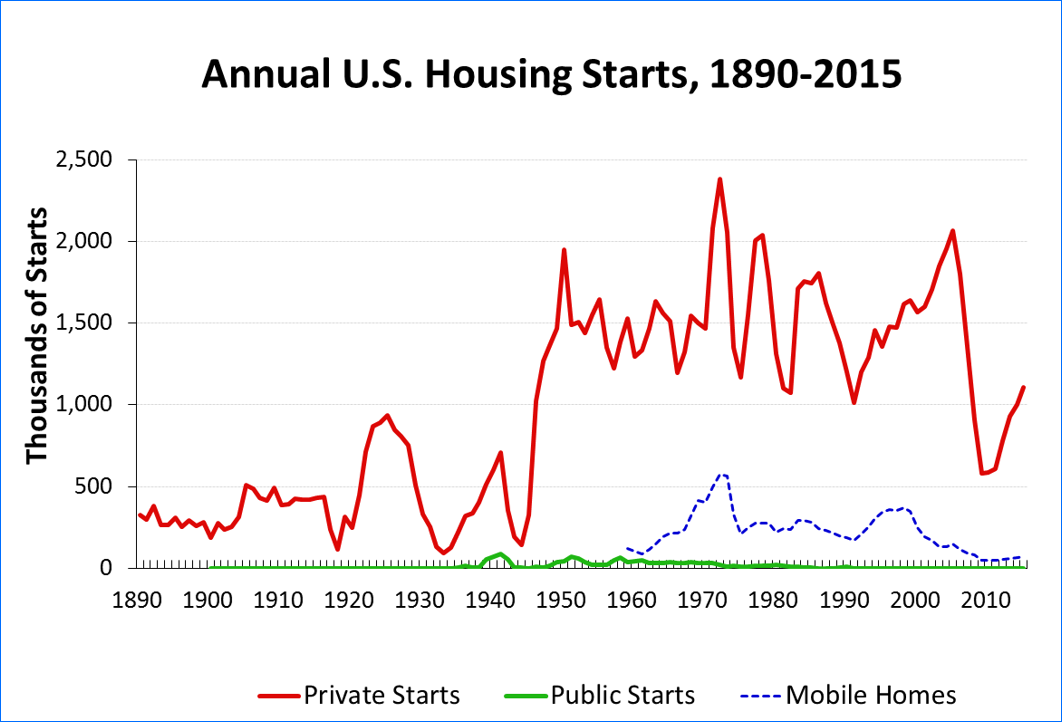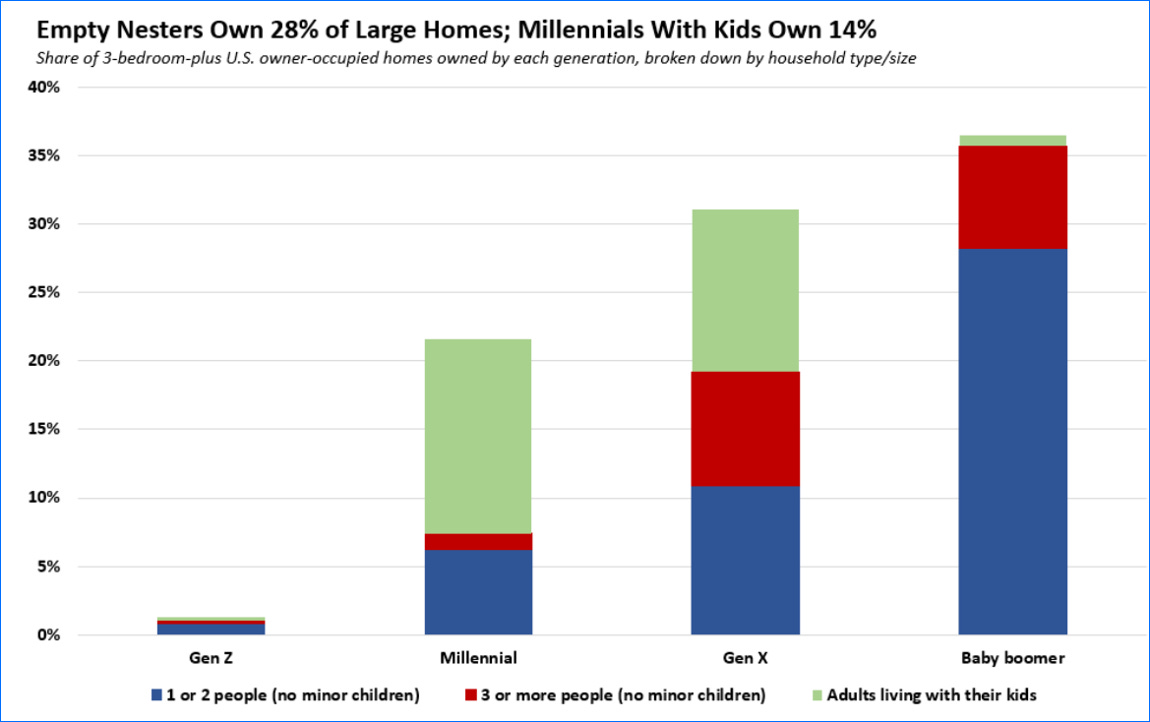We all understand the manifestations of the housing crisis:
Not enough units
Rental prices too high
House prices both too high, and interest and insurance rates making houses all the more unaffordable
But we can’t solve anything unless we understand the underlying causes of the manifestations. I’ll run through them, and then present some potential solutions.
Not Enough Units
If there were more houses to buy, and apartments to rent, the costs would come down due to the law of supply and demand. But after the housing crash in 2007, builders just plum stopped building. Depending on whose statistics you use, the US is missing between 3.2 and 5.5 housing units.
Let’s look at a few charts to understand the problem. This is a chart of total US population including a forecast through 2025. Notice how we keep growing…
We look at the available housing based on housing starts. Yes, there are existing homes, but they are likely either occupied, or in disrepair. I couldn’t get a single chart, so the first chart is from 1890 to 2015, and the second is from 2000 to the beginning of this year. That bump in the late 1940’s is due in large part to the GI bill. That sharp decrease in the late 2000-aughts is due in large part to bankers and brokers convincing people making $40,000/year that they could afford a $400,000 mortgage with a balloon. (That’s simplistic, but does sum it up.)
As you can see in the charts above, there is a HUGE deficit starting in 2008. And we obviously need more housing for our growing population, not to mention that there is a mismatch between “have” and “need”. The chart below shows the share of each generation, by number of household members, that own 3-bedroom homes. Source. The chart below is just one example, there’s an even greater divide when we look at 4- and 5-bedroom houses.
There are a lot of ways to increase the housing stock. Here’s one from the Harris campaign:
The Harris plan would create tax breaks for homebuilders focused on first-time buyers and expand existing incentives for companies that construct rental housing. Because local zoning often restricts the supply of homes, she would also double the available funding to $40 billion to encourage local governments to remove the regulations that prevent additional construction. Source.
Montgomery County, MD, is a leader in the push to get more housing. Read this article. I know that very few of you ever open a single link I post, but read the article. I PROMISE you it is an idea that would work in many places, it dovetails with the $40 billion the Harris plan proposes, and it will show you a solution you’ve never thought of. In addition, the same county just changed their zoning laws in June, it will enable the construction of more units on less land.
And remember, a lot of those Baby Boomer empty-nesters in 3-bedroom and larger houses don’t move because it would cost them more for a smaller place. If there were more supply, costs would decrease, and the Boomers could sell, and 4 person (or larger) families could move into the large Boomer houses.
Rental Prices
When I was studying Urban Planning in the 1970’s, we looked at cities with ring structures. That is, renters in the city, when they got older and started families, would move to inner ring suburbs that were reasonably priced, and buy starter homes. The people they bought from moved to an outer ring where they would buy a larger house, on a larger lot. Back then, we didn’t have exurbs and 3-hour commutes. A lot has changed with gentrification of cities, the rebuilding of inner ring suburbs, and the movement of jobs from the cities to the suburbs. Kalamazoo, MI presents a good example of some of those changes.
But mostly, IMHO, we have a huge problem with Airbnb, VRBO, and the like.
These cretins prey on the greed of homeowners, make living horrible for local neighbors, and greatly increase the cost of rental units. Especially in cities, but like a fungus, they’re spreading. Pretend you have an apartment with a monthly rent of $2,000. But you can do short-term rentals at $400/night. Meaning anything above 5 nights a month (less fees) is pure profit. If you can completely cover your rent many times over, you can buy or rent another place, and do it all over again. This decreases supply, increases demand, and rents skyrocket. It’s not just here: in Ibiza, Spain, it’s caused the development of tent cities for teachers, fire fighters, police as well as those doing day work. Source.
Certain cities and states are developing legislation to decrease the use of residential housing stock for short-term rentals. This is a start, but we need more. In the interim, if you travel, you can help by staying in a hotel, motel or B&B. You’ll help the local residents AND contribute to the local economy as those hotels, motels and B&Bs employ people!
Interest Rates
For those of us Baby Boomers who bought our first house in the 80’s, we remember mortgage interest rates well north of 10%. We were ecstatic when we could refinance at 6 or 7%. Today, people want rates down around 2%, although that is not going to happen soon. As interest rates drop, and the first drop of 25 or 50 basis points is expected from the Fed in September, it will actually drive up the price of existing housing stock.
Sound counterintuitive? Right now, there’s a dearth of houses on the market. Once interest rates drop, we’ll start seeing bidding wars again. Don’t believe me? I always want to be wrong about my projections…. but it normally doesn’t work out that way. Time will tell.
There’s no simple solution to the interest rate quagmire. When interest rates are zero, that’s a disaster because it means an economy is down the tubes. The solution is not low interest rates, but lower costs for building new housing stock. And this can certainly be accomplished with government help. (Again, read the links…)
Insurance Rates
In certain places, like Florida, California, Louisiana and Texas, the cost of home insurance is outrageously high. In Florida, for example, rates average $11,000/year exclusive of flood insurance, and that’s **IF** you can get coverage. Rates are high because of flooding, wildfires, climate change and other risks the insurance industry can’t cover with the amount they make in premiums.
There actually is no good solution to this: people keep rebuilding in the same areas that will flood again, burn out again, get destroyed by a tornado, or be swallowed by rising seas. They can try to live without homeowners’ insurance and flood insurance. In the long run, that won’t work well for most of them. The state-funded pools of last resort, especially in Florida, are raising rates, and cannot cover their losses.
40% of all Americans live in coastal counties, while that land area is only 10% of the country. Source. While there are also states with high insurance rates that are inland (like Oklahoma and Nebraska) due to tornado activity, the biggest losses are coastal.
Expect to see many “climate migrants” over the next several decades.
That’s all for now, although, trust me, I could talk about this for literally hours on end, it’s so fascinating and complex. We haven’t even talked about housing the unhoused, and yes, there are solutions for that imbroglio, too.
I’m taking off for Labor Day, back on Tuesday.








I sent this off to your cousin Mark, given that he is reputed to be among the best, if not the best, developers' attorney in New York. I asked him for his opinion on the efficacy of the Montgomery County housing initiative and will send it on whenever received, bearing in mind that he just returned from a week in Ireland and has to go back to his usually loaded in-box.
On another subject: i.e. the brouhaha over the Trump campaign's use of the Arlington National Cemetery for political purposes, decrying the "disastrous" Biden=Harris withdrawal from Afghanistan and blaming them for the Taliban takeover that followed. Isn't if time that someone pointed out that it was former President Trump who entered into a treaty with the Taliban agreeing to withdraw all U.S. forces from Afghanistan by August 2021, in essence confident that the Afghani armed forces which the U.S. had trained and spent billions of dollars training, supplying and paying for almost two decades would readily fend off any Taliban force? And wasn't it TFG's people who were in charge of that Afghan Army support for almost 4 years and must have warranted their readiness to take over ?Considering that we had spent almost two decades propping up the Afghan government and its Army, apparently no one in the US had any idea that the Army would throw away its weapons as soon as the plans for a withdrawal were announced. Given all of that, what were the alternatives: stick around for another useless decade or two; land more troops to assist civilian withdrawals; of get out while the getting was good? Given that the 13 U.S. heroes who died in the process was a genuine tragedy, they were the victims of a suicide bomber who somehow managed to escape detection and got close enough to create such havoc. In that context, give a thought (beyond TFG's capability) to how a sniper managed to almost assassinate TFG despite wads of Secret Service and local police personnel assigned to protect just him. Most important, how can the GOP blame Biden-Harris for the Taliban takeover when it was a GOP administration that got us there and another that agreed to get us out of there by a fixed date?